
archives for 01/2015
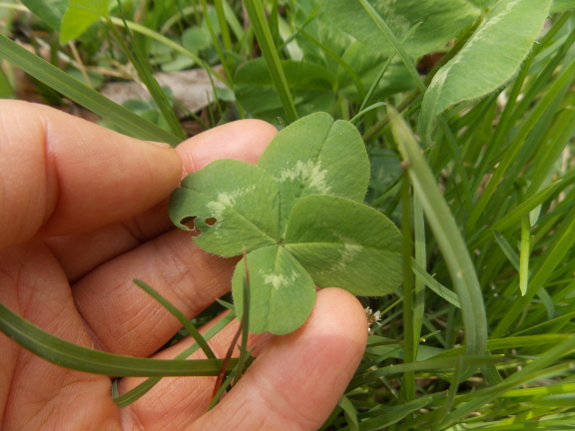
I really enjoyed wrapping up 2013 with a post highlighting my favorite on-farm moments, so I couldn't resist picking a top-10 for 2014 as well.
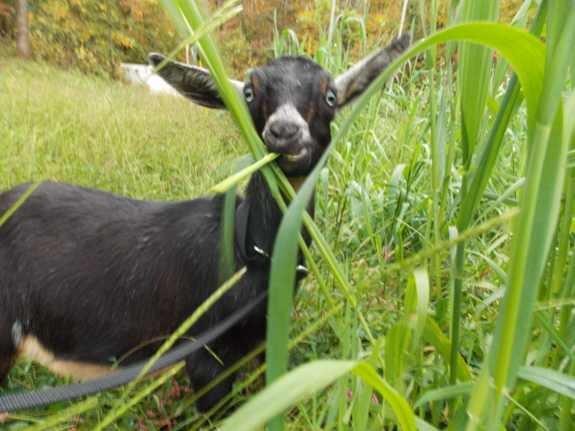
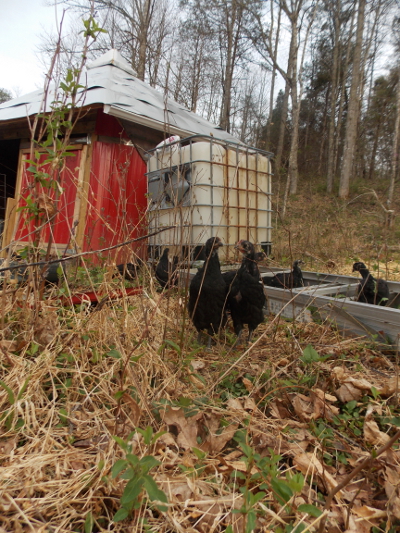 1. Goats!
How could my list not begin with these delightful caprine companions
who've made the last three months fly by? It was also a thrill to finish
the starplate coop, which initially housed chickens and soon turned into a goat shed. But, really, 2014 is all about the goats.
1. Goats!
How could my list not begin with these delightful caprine companions
who've made the last three months fly by? It was also a thrill to finish
the starplate coop, which initially housed chickens and soon turned into a goat shed. But, really, 2014 is all about the goats.
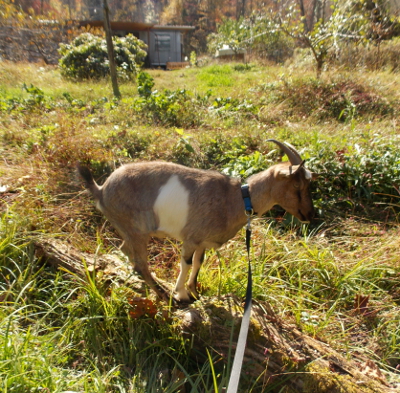
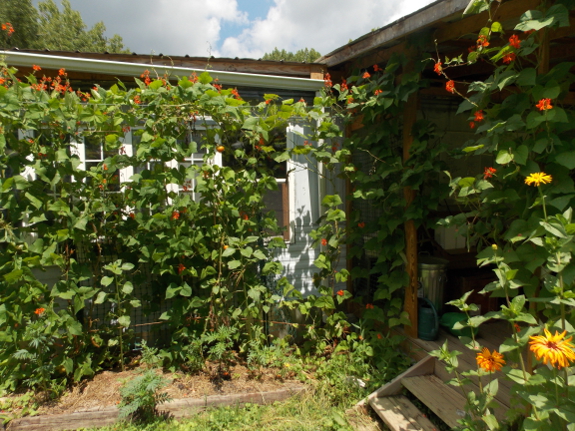
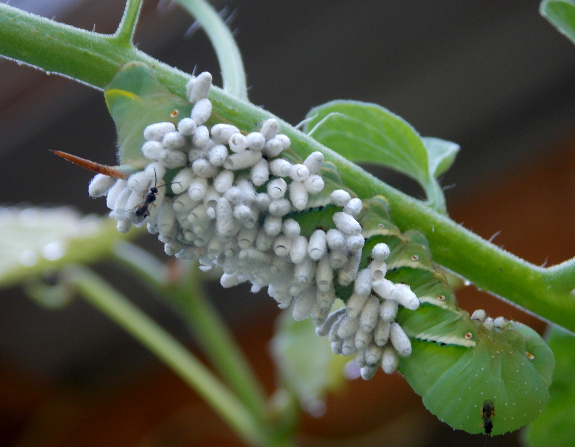 2. Flowers.
Taking the time to turn the front of the trailer into a riot of blooms
(that later produced edible beans) added about five hundred smiles to
2014. (Yes, of course I counted them all.) Plus, getting to watch
braconid wasps hatch along with other bits of daily life right outside
my window was truly inspiring.
2. Flowers.
Taking the time to turn the front of the trailer into a riot of blooms
(that later produced edible beans) added about five hundred smiles to
2014. (Yes, of course I counted them all.) Plus, getting to watch
braconid wasps hatch along with other bits of daily life right outside
my window was truly inspiring.
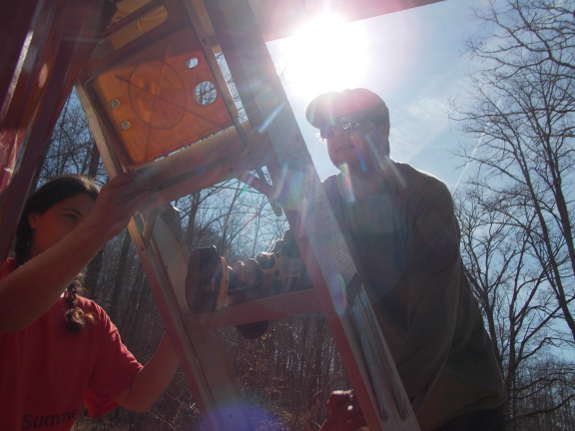
3. Working with friends.
My favorite times on the farm are nearly always when Mark and I are
working together as a team. Add in Kayla's occasional smiling presence,
and chores become a party.
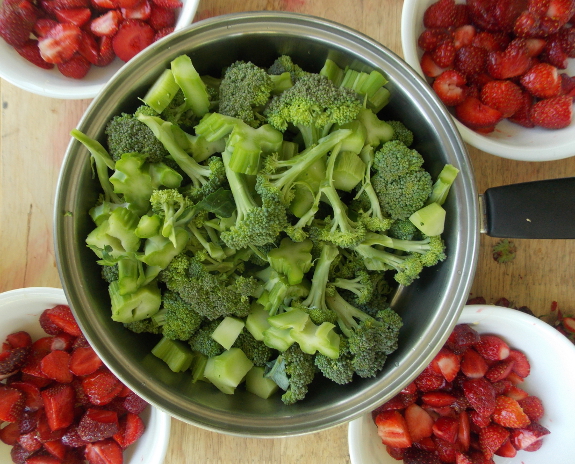 4. The year of the apple tree. Even though a late frost wiped out most incipient fruits, I had a ball training our high-density apples on a monthly basis. Adding in a grafting workshop
shared with a friend, then the pleasure of watching those little
grafted apple trees grow all summer, and 2014 definitely became the year
of the apple tree. While I'm talking plants, 2014 was also a
particularly awesome year for blueberries, peppers, and broccoli, and we
tasted our first homegrown hazelnuts this fall, which was quite a
treat!
4. The year of the apple tree. Even though a late frost wiped out most incipient fruits, I had a ball training our high-density apples on a monthly basis. Adding in a grafting workshop
shared with a friend, then the pleasure of watching those little
grafted apple trees grow all summer, and 2014 definitely became the year
of the apple tree. While I'm talking plants, 2014 was also a
particularly awesome year for blueberries, peppers, and broccoli, and we
tasted our first homegrown hazelnuts this fall, which was quite a
treat!
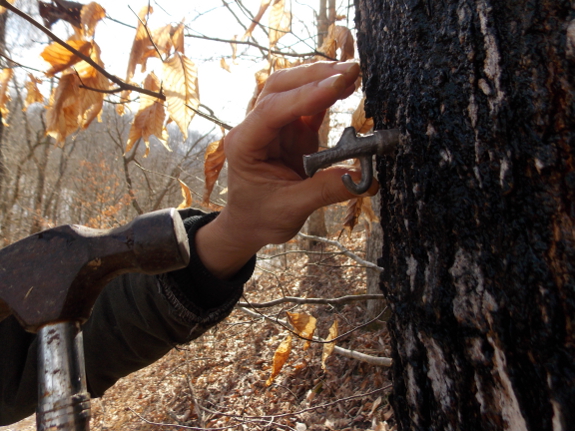
5. Maple syruping.
The great thing about homesteading is that every kind of weird weather
is an opportunity for something. A very hard winter made it worthwhile
to harvest maple syrup in February, even though the sap is usually too
watery to be worth collecting our climate. Cold weather never tasted so
sweet!
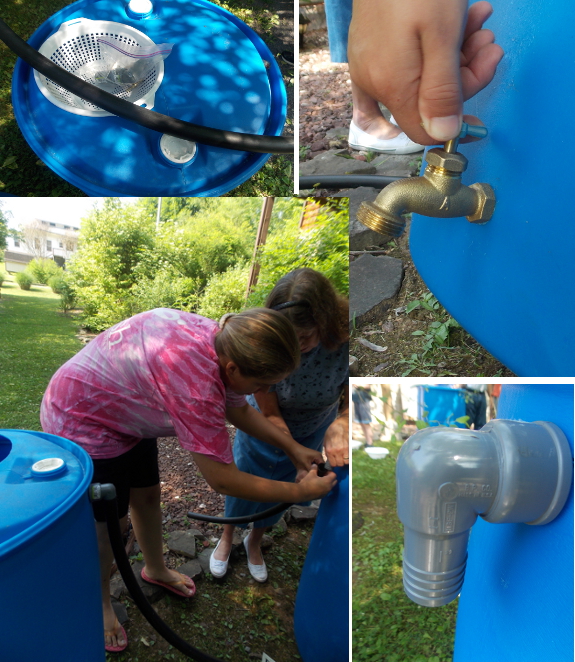
6. Rain barrel.
Speaking of attending workshops with Kayla, I was surprised by how much
the rain barrel we made together brightened my summer life. The
reservoir saved hours of lugging water and also made it easy to wash
hands and feet right outside the front door. Plus, the blue color just
looks cheerful.
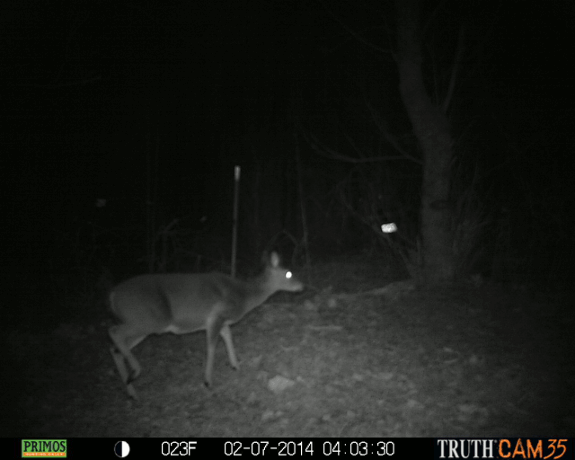
7. (Almost) no deer in the garden.
Boy do my stress levels stay lower when four-footed nibblers don't come
in the night to wipe out all my hard work. In a year or two, I may
forget to applaud Mark's fences, but for now, I'm still reveling in the
ability to keep deer out of the garden. (Unfortunately, lack of deer in
the garden equates to lack of deer in the freezer, but that's a
compromise I can live with.)
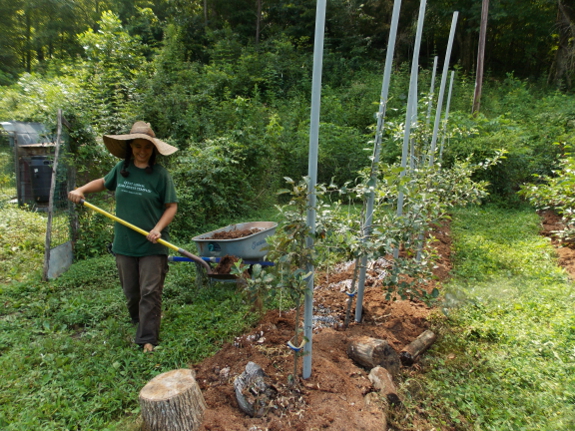
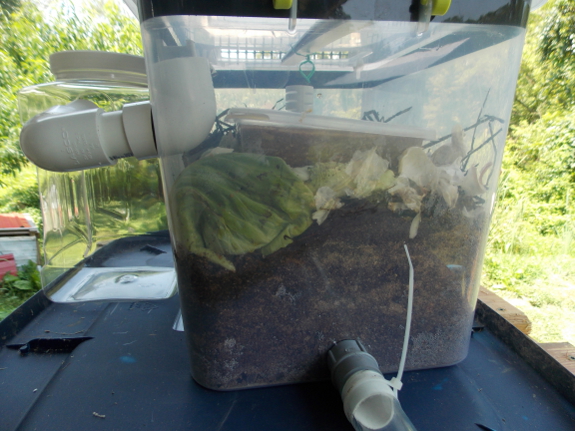 8. Full-circle compost. Scooping out the first humanure to feed the garden felt good since our fertility cycles are now more complete. Meanwhile, we also added a black-soldier-fly bin to our composting complex, which provided hours of entertainment for me and lots of yummy pupae for our chickens.
8. Full-circle compost. Scooping out the first humanure to feed the garden felt good since our fertility cycles are now more complete. Meanwhile, we also added a black-soldier-fly bin to our composting complex, which provided hours of entertainment for me and lots of yummy pupae for our chickens.
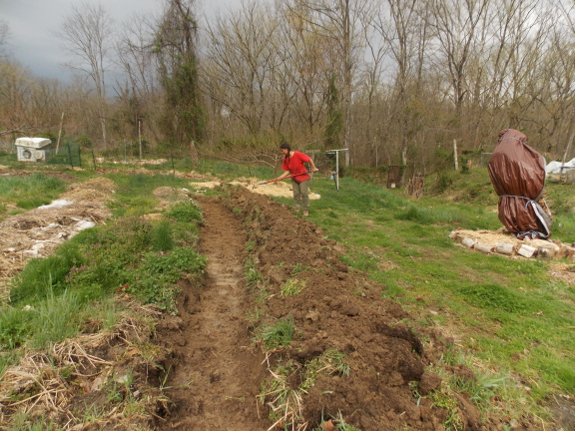
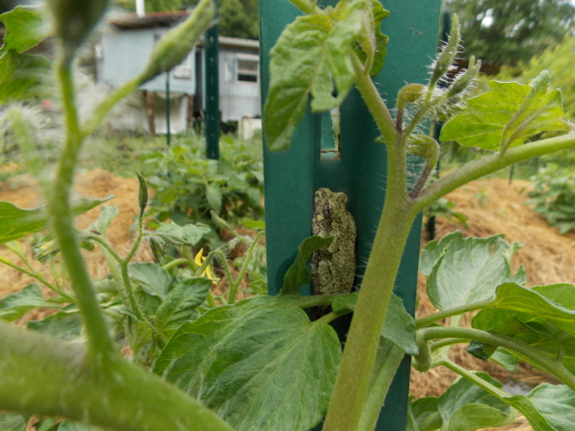 9. Experiments with terraforming.
I get a geeky kick out of trying out different methods of raising soil
above our high water table. As an added bonus, we were able to eat the
results of my experiments. Plus, wildlife loved the open water.
9. Experiments with terraforming.
I get a geeky kick out of trying out different methods of raising soil
above our high water table. As an added bonus, we were able to eat the
results of my experiments. Plus, wildlife loved the open water.
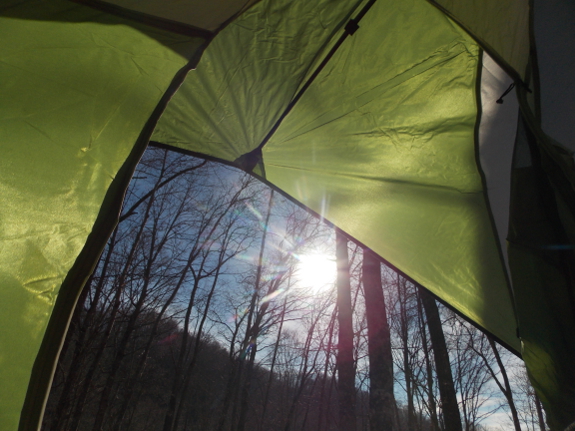
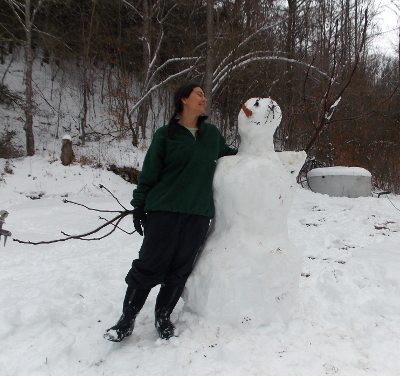 10. Remembering to have fun. Okay, so I only had about a 40% success rate in my goal of making up my own holiday for each month of the year,
but there were also several additional fun days thrown in here and
there. For 2015, I'm trying a new technique for chipping away at my
workaholic tendencies --- I used a random-number generator to pick one
day per month as a flash holiday, and marked all of the dates down on my
planner immediately. Let's see if I can hit at least an 80% success
rate this time around!
10. Remembering to have fun. Okay, so I only had about a 40% success rate in my goal of making up my own holiday for each month of the year,
but there were also several additional fun days thrown in here and
there. For 2015, I'm trying a new technique for chipping away at my
workaholic tendencies --- I used a random-number generator to pick one
day per month as a flash holiday, and marked all of the dates down on my
planner immediately. Let's see if I can hit at least an 80% success
rate this time around!
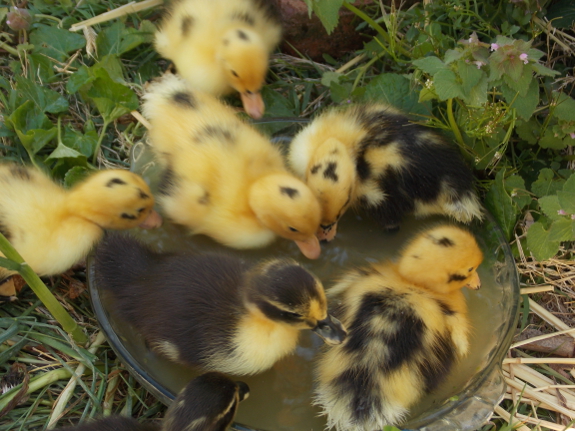
 I should also mention the ducks,
who were absolutely adorable when young but soon turned out to be not
quite our cup of tea. On the other hand, I always would have wondered
whether waterfowl were better than chickens if we hadn't given them a
try.
I should also mention the ducks,
who were absolutely adorable when young but soon turned out to be not
quite our cup of tea. On the other hand, I always would have wondered
whether waterfowl were better than chickens if we hadn't given them a
try.
And then there were minor
events like a trip to the beach and signing a contract for two more
print books to hit bookstores in 2015...but how could any of that
compete with the endless pleasure of apple trees, teamwork, and goats?
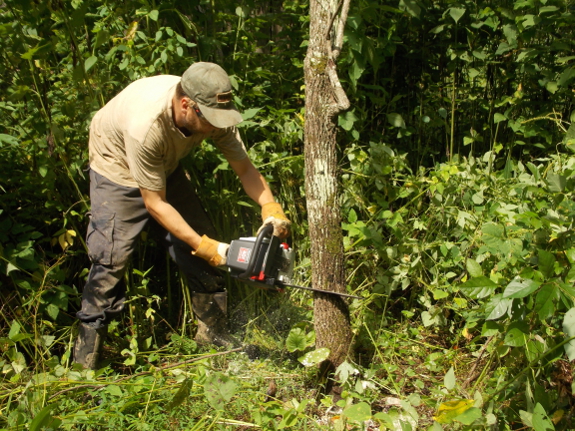 As
a final caveat, I feel obliged to add that this list is completely
Anna-centric. If Mark were writing a best-of-2014 post, I'll bet it
would include the battery-powered chainsaw and fancy new mower.
Or maybe all the time he got to rest and relax while I was writing up a
storm this fall and early winter? Regardless, 2014 has turned out to be
a top-notch year. Let's see if 2015 can top it!
As
a final caveat, I feel obliged to add that this list is completely
Anna-centric. If Mark were writing a best-of-2014 post, I'll bet it
would include the battery-powered chainsaw and fancy new mower.
Or maybe all the time he got to rest and relax while I was writing up a
storm this fall and early winter? Regardless, 2014 has turned out to be
a top-notch year. Let's see if 2015 can top it!
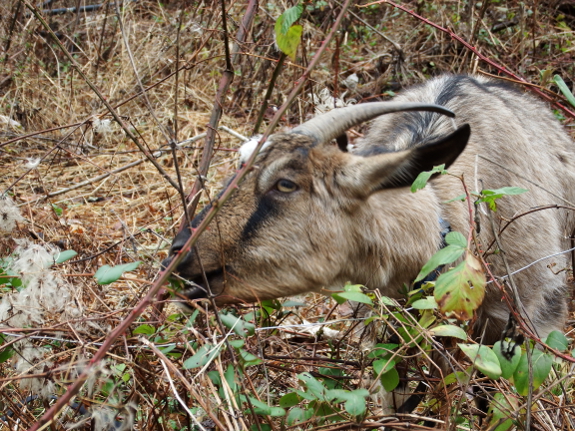
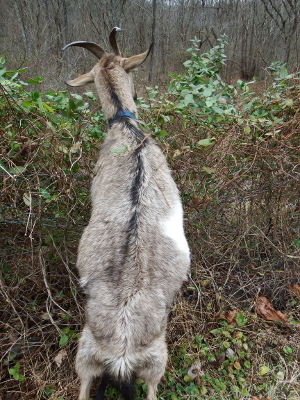 We don't know when or if Abigail is due
--- could be early February, could be early March, or could be never.
But I figure it's far better to be prepared for something that might not
happen rather than being caught without supplies when kids start
popping out.
We don't know when or if Abigail is due
--- could be early February, could be early March, or could be never.
But I figure it's far better to be prepared for something that might not
happen rather than being caught without supplies when kids start
popping out.
To that end, we had three
major decisions to make. The first choice was already decided by my
weak wrists --- carpal tunnel means that an automatic milker was a
necessity. We ended up choosing the Dansha Farm model
due to good reviews and low price, and realized in the process that we
won't have to buy a milking pail and strainer after all since the milk
stays clean with an automatic milker and goes right into a glass jar.
The other two decisions were thornier --- do we buy supplies for castrating males and for disbudding
both sexes? Our goal is to eat any male kids, which means we won't need
to castrate them --- here's hoping the cuteness quotient won't hold us
back when the time comes. (As a halfway house, we may take the kids to
the packing plant to be dispatched if we want the meat but can't quite
stand to pull out the knife.)
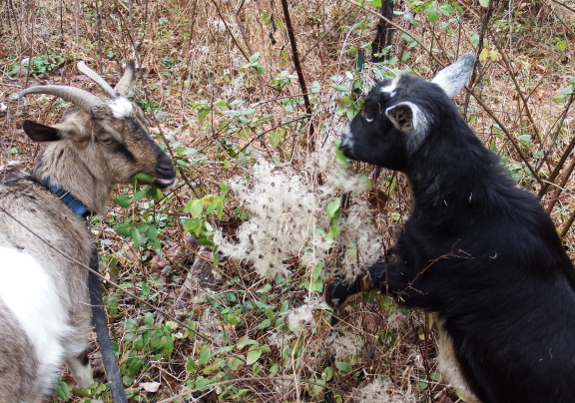
As for disbudding, Mark
does prefer our hornless goat, but he also isn't keen on the act of
disbudding (and he knows that the unpleasant task would inevitably fall
to him). Since Abigail is a mutt goat whose female kids probably won't
have too much value, we decided to skip the disbudding process and plan
to eat any of her girl children along with any males. After all, the
kids' value as pastured meat for us is probably greater than the cash
value they'd bring on the open market.
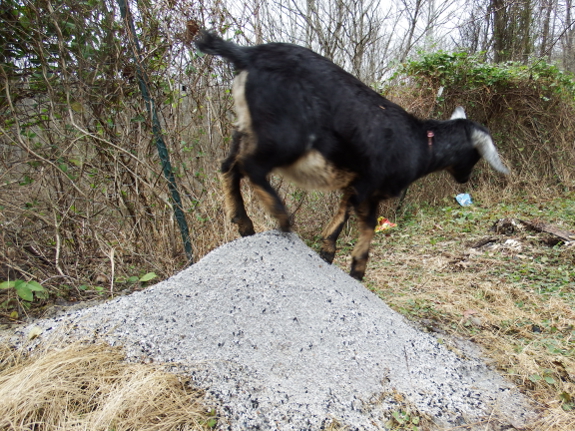
Decisions made, we can
now sit back and wait and hope. In the last couple of days, Abigail's
right side (where babies go) has suddenly started to look more like her
left side (where hay goes)...or maybe that's just wishful thinking.
Either way, Artemesia is still regaling us with kid-like cuteness and
sweetness, so I guess we'll survive even if Abigail didn't get knocked
up, although we would miss a spring full of milk.
No luck trying to substitute
a bolt for a proper punch tool today.
It took a trip to our nice
local mechanic who had just the right size punch with some advice on
banging it back once we get it seated on the ATV.
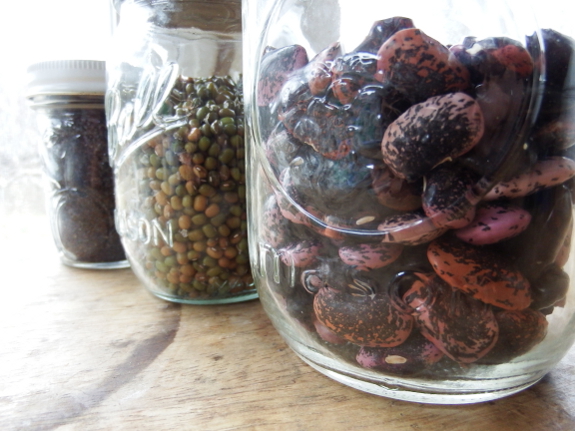
Working on polishing up
our recipes to turn into a cookbook has spurred me on to cook some of
our homegrown dried goods that I often forget about. I gave my sister
some of our scarlet runner beans
in December, and she recently told me that they tasted exceptional when
just stewed up in water. Mark's a reluctant bean-eater, so when I
cooked my own 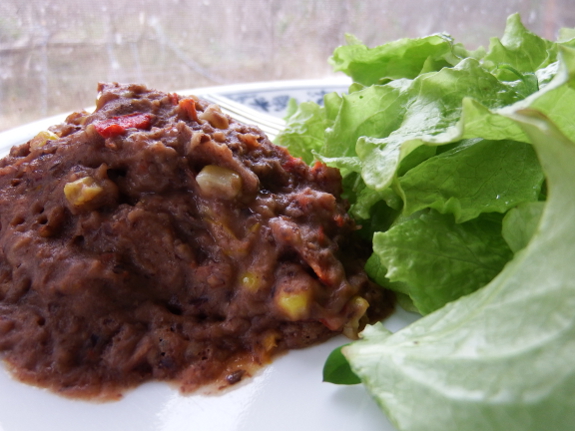 batch,
I resorted to diversionary tactics involving bacon, onions, frozen red
peppers, sweet corn, and cheddar...and my anti-bean husband liked the
dish so much that he snuck some extra beans out of the fridge while
cleaning up the kitchen!
batch,
I resorted to diversionary tactics involving bacon, onions, frozen red
peppers, sweet corn, and cheddar...and my anti-bean husband liked the
dish so much that he snuck some extra beans out of the fridge while
cleaning up the kitchen!
Now I just need to work on a good recipe for mung beans.
In the past, we've sprouted them and used the sprouts in tuna salad and
(sometimes) stir fries, but nothing I've made has really hit the spot
yet. Time to experiment!
As a side note, David is the winner of our cookbook-naming contest, with the awesome suggestion (slightly tweaked) of Farmstead Feast. David, be sure to email anna@kitenet.net to claim your prize!
The next step in our ATV
repair saga involves installing the repaired rear prop shaft pieces
back onto the drive gears.
Once we've got them on I'll
need some sort of brace to absorb the impact of banging in the final
pin.
An old scissor
jack might do the trick.
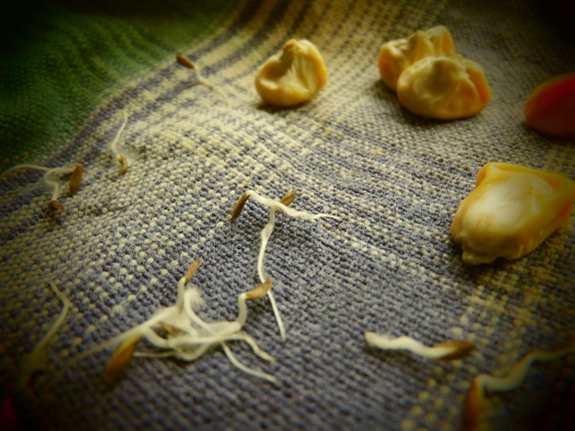
Around the first of the
year, the days start getting noticeably longer. As a
photoperiod-sensitive gardener, that means I suddenly crave earth
beneath my fingertips and green leaves in front of my nose.
For the first week, I tide myself over by doing a seed-starting test
on old seeds and browsing online seed offerings to round out this
year's stash. In case you're curious, I've settled on Johnny's as my
favorite seed company --- their prices are about twice what you'd find
elsewhere, but the varieties nearly all make the cut, while my
experience with other companies suggests that many of their varieties
are geared toward the hobbyist rather than the serious food producer.
Although my skinflint-nature tries to tell me otherwise, I'm positive we
make that $100 back many times over during the course of the growing
season in the form of bountiful produce.
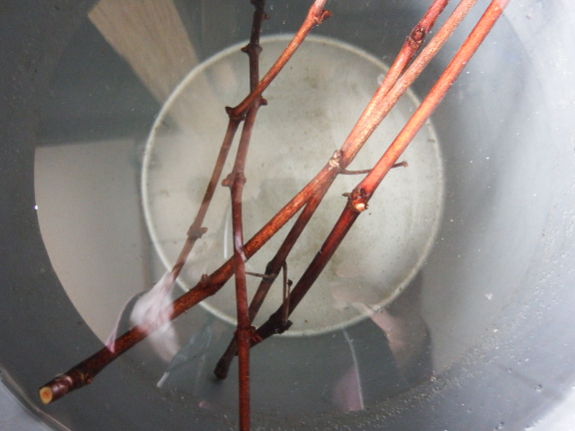
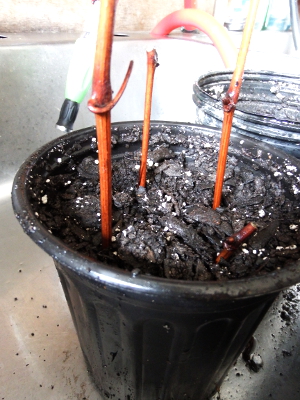 Seeds sprouted and ordered, the next order of business is hardwood cuttings. In my early days on the farm, I've started hardwood cuttings out in the garden
--- and that definitely works. But I get higher success rates
indoors...and being able to check on a plant (even if it is just a stick
in a pot) soothes my gardening itch for a little while longer. This
year, I'm rooting grape cuttings to expand our sun-shielding vines around the trailer.
Seeds sprouted and ordered, the next order of business is hardwood cuttings. In my early days on the farm, I've started hardwood cuttings out in the garden
--- and that definitely works. But I get higher success rates
indoors...and being able to check on a plant (even if it is just a stick
in a pot) soothes my gardening itch for a little while longer. This
year, I'm rooting grape cuttings to expand our sun-shielding vines around the trailer.
Next on the agenda?
Hunting down scionwood for the spring-grafting extravaganza. If you're
interested in swapping, I've got scads of interesting things to trade
and am looking for named American persimmon varieties (especially Szukis
and Mohler) and fire-blight-resistant pears (specifically Blake's
Pride, Magness, Moonglow, and Potomac). Want to trade? Email me at anna@kitenet.net and we'll talk!
Sometimes during firewood
chopping we get a knotty log that takes more than a few whacks to split.
That's when the ease of
starting up the Oregon battery
powered chainsaw really shines.
A lot less calories burned
compared to fueling up the old chainsaw and pulling her to life.
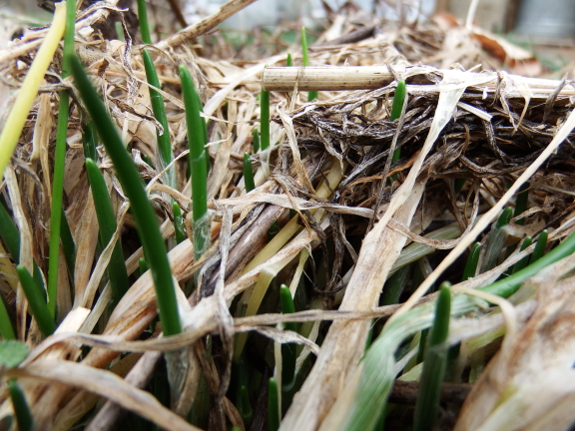
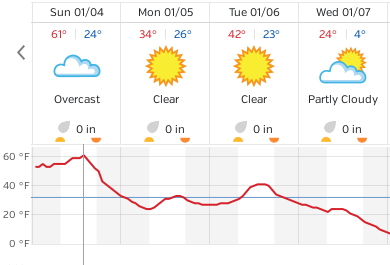 If
there's one thing you can depend on about our weather, it's that the
weather's always changing. After a very harsh November, December was
remarkably mild, but January is coming in with a vengeance. We enjoyed a
spring-like day in which I didn't even bother to light a fire, but then
roaring winds up above the hills (which I can hear but not feel) marked
the beginning of the end of the warm weather. By Tuesday, the low is
forecast to drop to 4 degrees Fahrenheit, which could be -4 here in our
frost pocket. I guess the bees won't come out flying again this week!
If
there's one thing you can depend on about our weather, it's that the
weather's always changing. After a very harsh November, December was
remarkably mild, but January is coming in with a vengeance. We enjoyed a
spring-like day in which I didn't even bother to light a fire, but then
roaring winds up above the hills (which I can hear but not feel) marked
the beginning of the end of the warm weather. By Tuesday, the low is
forecast to drop to 4 degrees Fahrenheit, which could be -4 here in our
frost pocket. I guess the bees won't come out flying again this week!
 Mark
and I pondered whether we should be doing anything special to prepare
for the deep freeze, but we're used to winter cold by now and don't
foresee many difficulties. Our water line will freeze, so we'll stock up
on a pail of water in the kitchen, and we'll make sure to have extra waterers for goats and chickens inside and ready to take out during cold mornings. I'll probably take the carrots in from our fridge root cellar
since we're down to the last quarter bushel, but I have high hopes that
residual warmth in the ground will prevent this cold spell from doing
too much damage to living things in the garden.
Mark
and I pondered whether we should be doing anything special to prepare
for the deep freeze, but we're used to winter cold by now and don't
foresee many difficulties. Our water line will freeze, so we'll stock up
on a pail of water in the kitchen, and we'll make sure to have extra waterers for goats and chickens inside and ready to take out during cold mornings. I'll probably take the carrots in from our fridge root cellar
since we're down to the last quarter bushel, but I have high hopes that
residual warmth in the ground will prevent this cold spell from doing
too much damage to living things in the garden.
In other news, the
Laughing Buddha that my father bought for me when I was in high school,
recently relocated to our farm, doesn't seem fazed by the forecast cold.
Both of his hands broke off long ago, but he just keeps smiling and
dancing --- how can we do anything but emulate his mirth?
Our neighbor brought his 4
wheel drive tractor over and pulled our truck to freedom!
We were planning on getting
everything staged for the big freeze, but Frankie wanted to give it a
try today and we're so glad he did.
He had an extra long cable
and knew just how to hook it up.
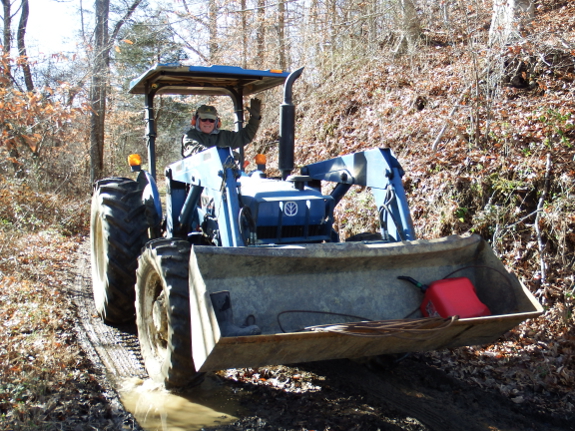
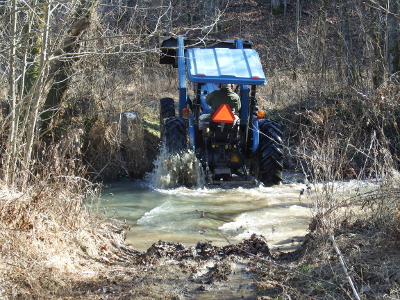 After five months stuck in the mud of the floodplain, our truck is finally free!
Our movie-star neighbor deserves a medal for knowing just how to use a
long cable with a tree as a fulcrum point to yank out the truck on the
other side of a bend without getting bogged down in the muck. Plus, his
tractor just happens to be almost-but-not-quite-too-big to go up the
ford --- what luck!
After five months stuck in the mud of the floodplain, our truck is finally free!
Our movie-star neighbor deserves a medal for knowing just how to use a
long cable with a tree as a fulcrum point to yank out the truck on the
other side of a bend without getting bogged down in the muck. Plus, his
tractor just happens to be almost-but-not-quite-too-big to go up the
ford --- what luck!
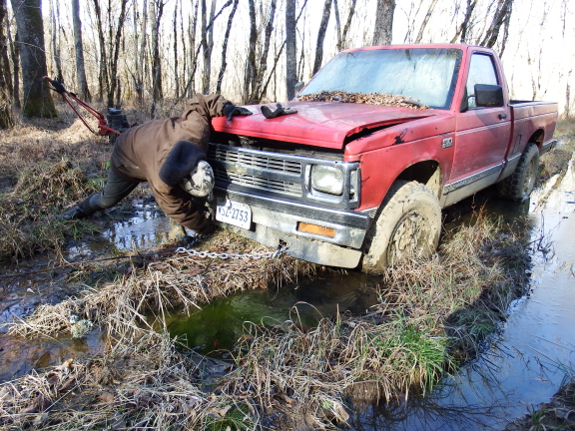
A short chain and a long
cable turned out to be the perfect attachment for full-frontal pulling. I
think I'm doing a yoga position in this photo --- perhaps Stuck Truck
Warrior?
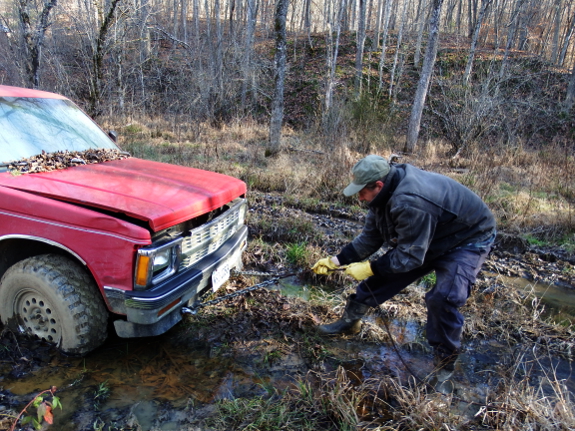
No, Mark, you can't pull
the truck out all by yourself. (Actually, Mark's testing the chain in
this photo to make sure it's hooked in properly.)
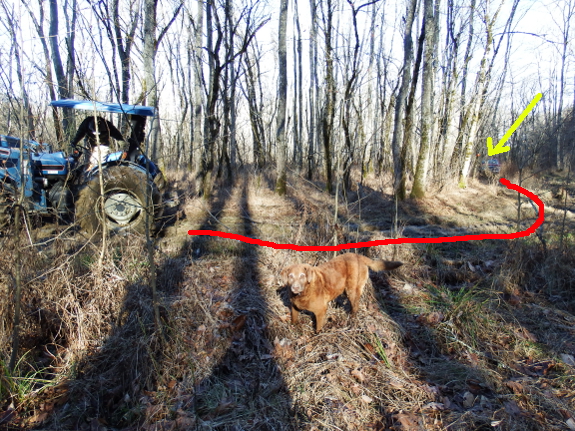
I'll admit up front that
Mark and I were both dubious of our neighbor's choice of days. I mean,
look at the driveway --- it was wetter than ever. Shouldn't we wait
until the deep freeze, at least?
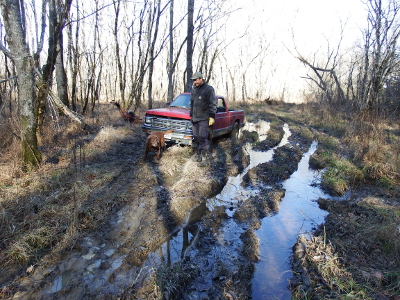
"Nope," our neighbor
replied. He kept the tractor in the (semi-)dry, then let a long cable
rub up against a tree at the curve. With Mark steering the truck and our
neighbor driving the tractor, our mud-encrusted vehicle was yanked free
in no time. The diciest part of the whole endeavor was the way Lucy
kept trying to jump up into the moving truck in search of a mouse that
had taken up residence under the hood.
Here's where I admit that
our neighbor was 100% right and we were 100% wrong. We owe you one,
Frankie! I'll never doubt you again.
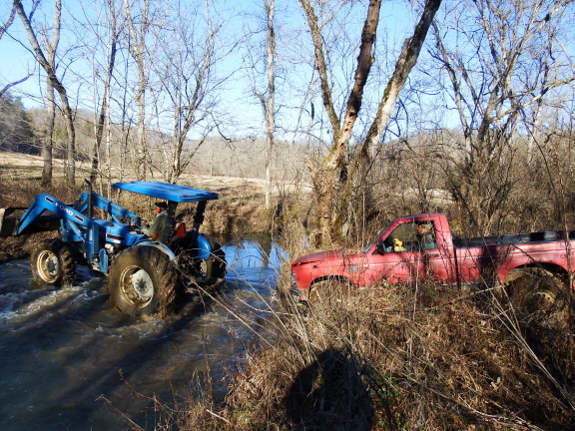
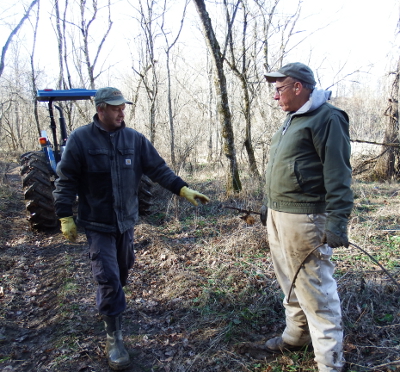 Of
course, this doesn't mean we have two vehicles on the road once again.
Frankie actually pulled the truck another mile down the road to our
other neighbor's garage since the truck no longer wants to run after you
get the engine going. Surprise, surprise --- five months in a swamp
wasn't good for the truck's moving parts.
Of
course, this doesn't mean we have two vehicles on the road once again.
Frankie actually pulled the truck another mile down the road to our
other neighbor's garage since the truck no longer wants to run after you
get the engine going. Surprise, surprise --- five months in a swamp
wasn't good for the truck's moving parts.
But we're thrilled
anyway. Not seeing the truck sunk nearly up to its axles as we walk past
will make us much happier on a daily basis. And today also marked the
day when yet another neighbor (this time the one who gave us our trailer
many moons ago) dropped by to scope out the possibility of carving a
non-swampy driveway into the side of our hill. More details on that
potential project in a later post.
We installed the wall
cap today for the new
range hood.
It's got a damper on it that
blocks air from coming in while the hood is not being used, but we
might make an additional cover to help reduce as much heat loss as
possible.
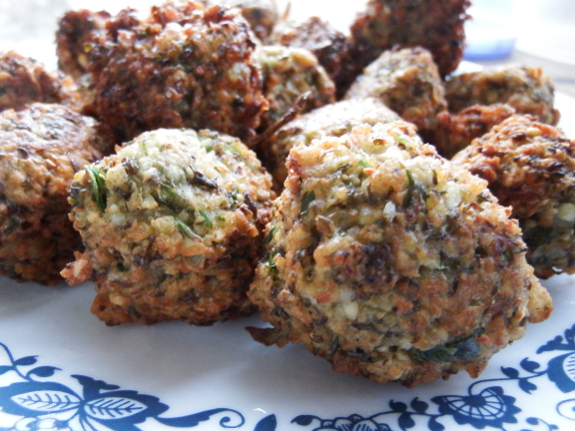
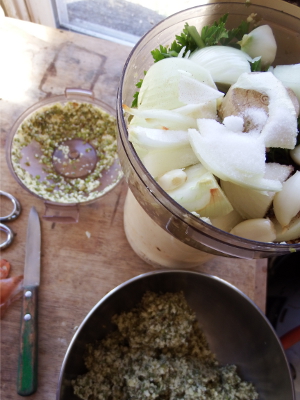 I've
had falafels a few times in restaurants, but only nibbled because I had
no clue what was in them and wasn't sure if they passed the
good-for-you test. This week, I made my own for the first time and
discovered that falafels are a unique combination of very high-quality
ingredients...and deep frying.
I've
had falafels a few times in restaurants, but only nibbled because I had
no clue what was in them and wasn't sure if they passed the
good-for-you test. This week, I made my own for the first time and
discovered that falafels are a unique combination of very high-quality
ingredients...and deep frying.
What makes the ingredients so good? You basically begin to sprout the beans (traditionally garbanzos or favas, but we used mung beans)
by soaking them for 24 hours, so they probably have many of the
nutritional qualities of sprouts. To that, you add herbs and spices,
then fry just barely long enough to cook the centers. (As this was my
first learning experience, I actually didn't quite cook some of the
centers --- smaller balls or flattening them into cakes would be called
for next time around.)
I used this recipe,
slightly tweaked, and found the result very tasty, although perhaps a
bit higher in onion than I'd like. For our next experiment, Mark
suggested replacing half of the beans with canned salmon, then frying
like cakes rather than deep-frying. Good thing we've got more mung beans
to experiment with!
We got our repaired rear prop
shaft installed on the ATV today.
I decided to replace the pin
with a bolt and locking nut.
Next up is to figure out why
it won't start.
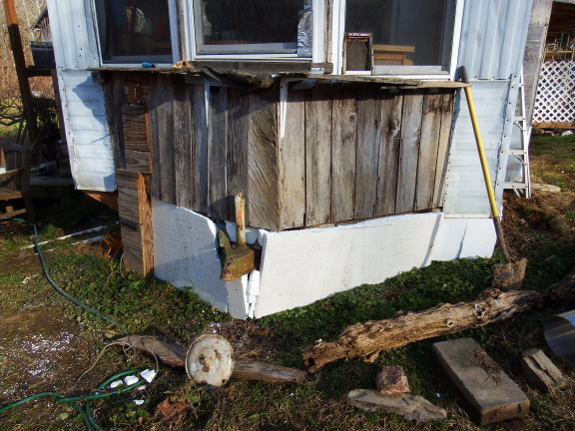
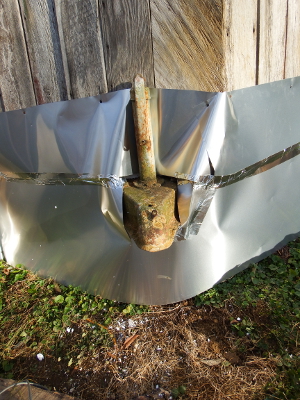 The last gasp of warmth (high of 41) before the cold hit seemed like a good time to continue my skirting project,
which is now moving around to the west side of the trailer. This area
is home to the hitch --- the big metal thing that connects to a truck
when a mobile home is being hauled to a new location. As a result of the
hitch, I ended up having to do a bit of piecework with the insulation,
but hopefully it will still mostly do its job.
The last gasp of warmth (high of 41) before the cold hit seemed like a good time to continue my skirting project,
which is now moving around to the west side of the trailer. This area
is home to the hitch --- the big metal thing that connects to a truck
when a mobile home is being hauled to a new location. As a result of the
hitch, I ended up having to do a bit of piecework with the insulation,
but hopefully it will still mostly do its job.
Meanwhile, since our
trailer is set atop slanted ground, the downhill part of the west face
of the trailer presented yet another obstacle --- the flashing is no
longer wide enough to reach from the walls to the ground. I overlapped
two pieces of flashing and sealed the seam with that metal tape you use
to seal ductwork (not duct tape --- or perhaps this is real
duct tape?). Only time will tell whether the little bit of rain this
area gets beneath its large overhang will be sufficient to work the tape
loose, but since I only taped the seam for aesthetic purposes, we can
live with untaped seams if they occur.
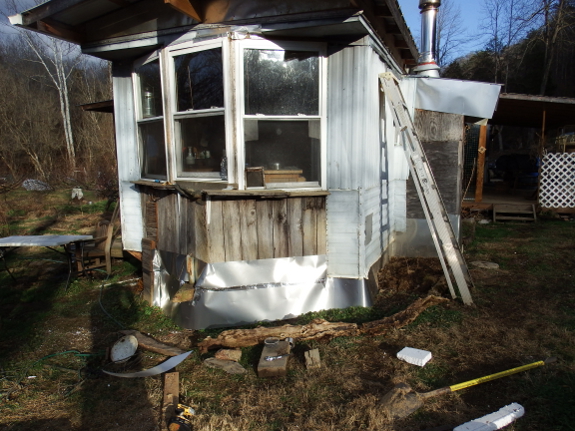
Next step will be
mounding soil up around the base of the skirting the way I did on the
southwest end of the trailer. I let Mark be the final deciding vote on
planting this area and he chose grapes, so the cuttings I started
will end up in this area come spring. And, in the meantime, I'll keep
plugging away at skirting as weather permits. Next up is the soggy north
face of the trailer, where I hope to include an access door just in
case we someday need to crawl beneath our mobile home.
We got the new range hood
wired up and mounted.
Next up is to install some
rock board on top with a shelf on top of that.
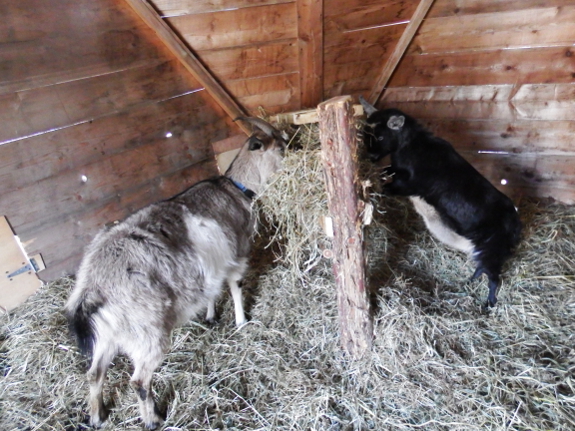
Sometimes, I think that
humans would be 100% happier if we were 25% dumber. I woke at 4:30 on
Thursday morning, worried about what the deep freeze would do to our
animals, but when the day finally dawned at a chilly 1 degree
Fahrenheit, the animals were happy as can be. Lucy seems to become
bouncier the colder it gets, the goats were waiting at the gate for
their breakfast, and the ducks ran straight out the door and into the
creek, where flowing water must have felt like a sauna at 31 degrees
warmer than the air.
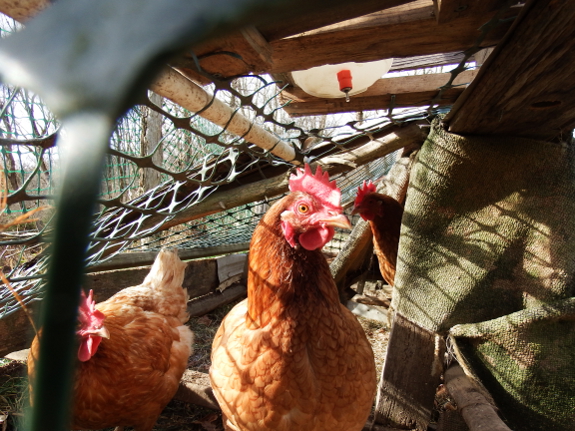
I heated everyone's
morning drinking water, but only the tractored hens seemed particularly
interested. They were also the only ones who ran to the lunchtime waterer
I brought out to refresh their now-frozen morning offering. I guess
everyone else was too busy exploring the frozen world to want fresh
water.
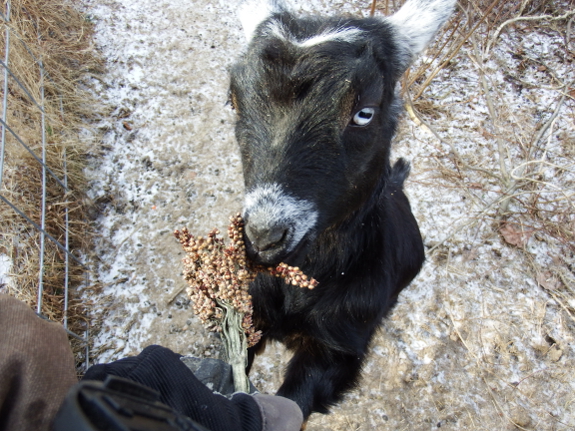
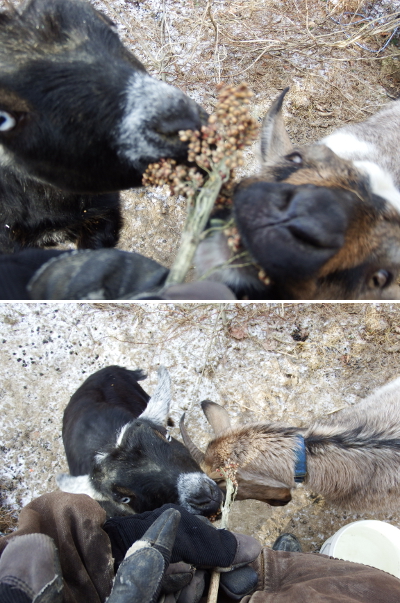 Our
goats seemed more interested in the sorghum seed head that I treated
them too --- a rare bit of grain for a cold day. Perhaps I should have
brought two heads, but Artemesia seems to hold her own nowadays. Our
larger goat inevitably head-butts the smaller goat when they're supposed
to be sharing, but Artemesia simply ignores the jab in the ribs and
keeps eating away. In fact, this time around, Artemesia got the lion's
share of the treat since Abigail was too busy fighting to chow down.
Maybe there's a lesson there? The sweetest goat gets the grain?
Our
goats seemed more interested in the sorghum seed head that I treated
them too --- a rare bit of grain for a cold day. Perhaps I should have
brought two heads, but Artemesia seems to hold her own nowadays. Our
larger goat inevitably head-butts the smaller goat when they're supposed
to be sharing, but Artemesia simply ignores the jab in the ribs and
keeps eating away. In fact, this time around, Artemesia got the lion's
share of the treat since Abigail was too busy fighting to chow down.
Maybe there's a lesson there? The sweetest goat gets the grain?
Stay warm out there!
We got the ATV running today.
The 4 wheel drive gave out as
I was trying to drive up the ford.
Anna and I spent most of the
afternoon winching and pushing to get it back out to the parking area
so we can haul it to an expert.
TGIF!
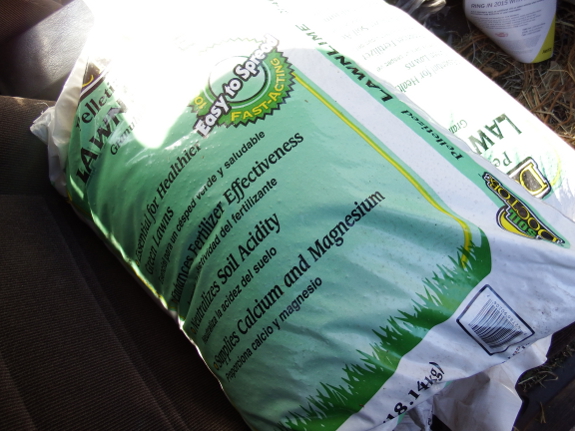
If you're thinking of
adding lime to your garden, be sure to select the right kind ---
dolomitic if your soil needs a boost in magnesium as well as calcium or
non-dolomitic if your soil (like ours) is already too high in the former
mineral.
Unfortunately, our local
feed-store clerks have no clue what I'm talking about when I ask for
non-dolomitic lime. Poor Mark had hefted all three of these bags onto
the ATV in preparation for carting them back to our core homestead
before he noticed the error. Next time, maybe I'll break outside my
hermit patterns and go along to help him select the proper minerals.
It's the first time this
Winter we've had to break an ice hole in the tank for some fresh dish
water.
One of these days I'm going
to make a shoulder yoke and see if carrying a bucket on each side would
be smarter.
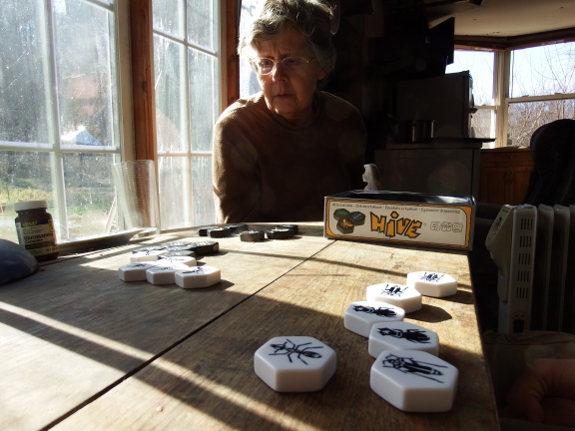
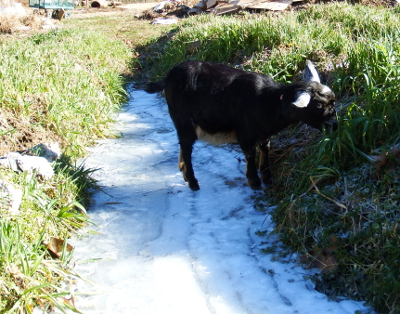 Every few years, Joey buys me a new homesteading-related game. The newest addition is Hive, a game that reminds me a bit of Carcassonne mixed with chess.
Every few years, Joey buys me a new homesteading-related game. The newest addition is Hive, a game that reminds me a bit of Carcassonne mixed with chess.
Mom and Mark were kind enough to let me try it out before Joey's next
visit. Gotta get a headstart if I want to be any competition at all for
my big brother.
My review? Hive is a fast, fun game that I could play all day...if the goats weren't hollering for a honeysuckle-and-oats snack.
After playing Hive last night and this afternoon Anna and I have decided this is a fun and addictive game, kind of like chess with bugs.
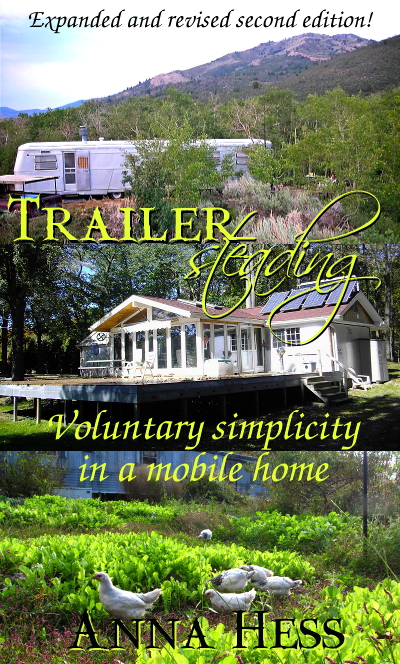 Thanks to the cold weather keeping me indoors last week, the expanded and updated second edition of Trailersteading
is now live on Amazon. I know that the right thing to do from a
marketing perspective is to withhold this second edition until the
paperback comes out this fall...but instead I'm doing exactly the
opposite. For one day only, I've set Trailersteading free on Amazon so
that all of my loyal fans can download a copy!
Thanks to the cold weather keeping me indoors last week, the expanded and updated second edition of Trailersteading
is now live on Amazon. I know that the right thing to do from a
marketing perspective is to withhold this second edition until the
paperback comes out this fall...but instead I'm doing exactly the
opposite. For one day only, I've set Trailersteading free on Amazon so
that all of my loyal fans can download a copy!
For those of you who
already have a copy, stay tuned --- hopefully Amazon will be contacting
you soon to give you a chance to download an updated version to your
kindle. And, if you're not familiar with Amazon ebooks, it's
easy to read them even if you don't own a kindle. My favorite way is to
simply read in Amazon's cloud reader, which means you see the ebook in
your web browser. But Amazon has lots of apps available too so you can
read on your computer, phone, or other device. See this page for more details.
Finally, unlike the recent sales that were only active in the U.S. (sorry!), this freebie should
be available world-wide. But you probably can't use the link I provided
--- instead, go to your country's Amazon store and type
"Trailersteading" into the search box to get your free copy.
Thanks for reading, and
if you like what you see, please consider leaving me a review. Your kind
words are what help strangers decide to take a chance on my books and
they earn my undying gratitude.
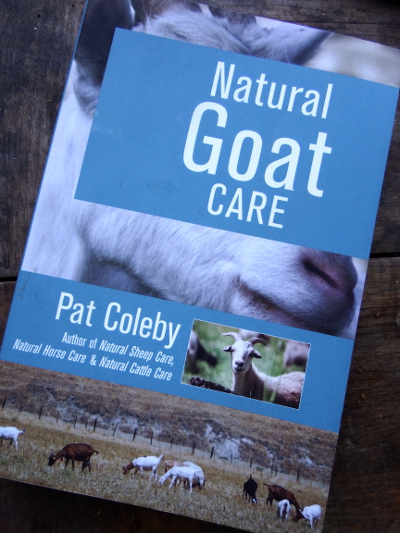 Back when I posted about goat books for beginners, I said that I was just starting to read Natural Goat Care
by Pat Coleby and was really enjoying it so far. Unfortunately, as I
kept turning pages, I slowly lost my faith in the author's analyses as
they relate to American farms.
Back when I posted about goat books for beginners, I said that I was just starting to read Natural Goat Care
by Pat Coleby and was really enjoying it so far. Unfortunately, as I
kept turning pages, I slowly lost my faith in the author's analyses as
they relate to American farms.
The trouble is twofold:
Coleby isn't very scientifically minded and she lives in Australia, so
the American reader needs to take all of her assertions with a major
grain of salt. For example, I suspect that Coleby is right that minerals
are essential to keeping goats healthy, but I cringe a bit when I hear
American goatkeepers using her feeding formula precisely as she lists it
in her book. Our soils are completely different from Australian soils,
which suggests that the supplements our goats need are also likely to be
quite different. Coleby pushes dolomite very hard as one of her
cure-alls, but are goats raised on browse in an area like ours with very
high magnesium in the soil likely to be deficient in magnesium?
Probably not. Similarly, she feeds a lot of grain to her goats because
Australia is so dry that it's probably close to impossible to keep goats
happy on pasture and root vegetables, but grain isn't a good choice for
most American goatkeepers. In the end, this isn't so much a fault in
the book as a fault in the lack of critical thinking on the part of her
American readers, who follow Coleby's lead blindly without assessing
their differing habitats.
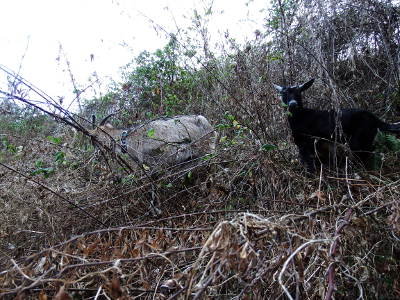 However,
the book does have its own faults. As one small example, Coleby talks
about Mendelian genetics in the chapter on breeding, and shows a clear
misunderstanding of statistics. Mendelian genetics is all about
percentages --- if you're likely to see 50% of one phenotype, that
doesn't mean that if your goat has two kids, one is definitely going to
show the phenotype and one definitely isn't. However, Coleby clearly
thinks that's the case, which throws her understanding of basic
biological principles into question.
However,
the book does have its own faults. As one small example, Coleby talks
about Mendelian genetics in the chapter on breeding, and shows a clear
misunderstanding of statistics. Mendelian genetics is all about
percentages --- if you're likely to see 50% of one phenotype, that
doesn't mean that if your goat has two kids, one is definitely going to
show the phenotype and one definitely isn't. However, Coleby clearly
thinks that's the case, which throws her understanding of basic
biological principles into question.
The trouble is that after
a few assertions that are obviously not universally true, I began to
lose faith in the author of the book. I feel that this book would have
been a much better fit for an American audience if it had come with an
introduction explaining the differences between Australian and American
goatkeeping, and if the author had made clear which of her assertions
were backed up with data and which were simply her own guesswork. As it
is, I would hesitate to recommend this book to anyone without a science
background since I suspect Coleby's regimen could do more harm than good
if followed blindly. On the other hand, if you're able to think
critically, this book will provide some food for thought and is a good
addition to your goat-keeping library.
A lost dog found his way back
to our farm today.
He's got a choke chain but no
tag, and he's very friendly and obedient.
We posted a photo at the
local post office bulletin board. Hopefully we'll find his owner, but
if that fails we'll try to find him a good home.
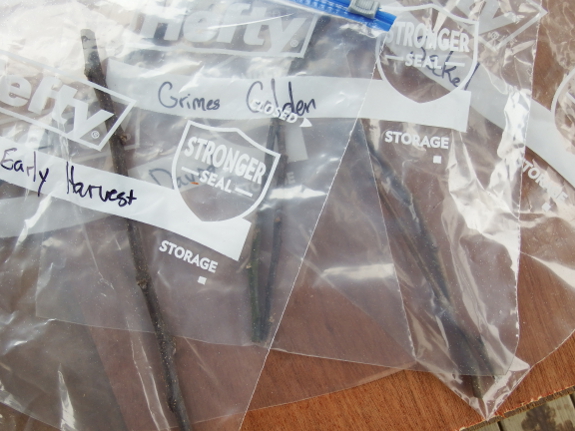
My scionwood swaps this year are intended to expand our pear varieties in preparation for a planned high-density planting.
To that end, I'll soon be receiving Shinko, Leona, Potomac, Maxine,
Moonglow, and Blake's Pride scionwood, and I recently mailed out
heirloom apple and pear scionwood to pay back my pear sources. I won't
go into more details about swapping in this post because I've written
previously about how to match yourself up with other scionwood swappers, along with the basics of how to turn your found scionwood into new trees. Suffice it to say that scionwood swapping is easy, cheap, and fun!
When it comes to grafting
that scionwood onto roostocks, though, pears can be trickier to graft
than their appley cousins because some pear varieties aren't compatible
with certain rootstocks (especially the quinces that used to be used as
dwarfing rootstocks for pears). Luckily, the introduction of OHxF (Old
Home x Farmington) rootstocks, which are in the same species as the
European pear (Pyrus communis)
while still providing some dwarfing characteristics, make the
incompatability issue less pressing. Asian pears, on the other hand, are
often grafted onto more vigorous rootstocks in the species Pyrus betulaefolia, but I'm hoping that my one Asian pear (Shinko) will do okay on OHxF 513 like the rest of my new trees.
I know, I know --- too much plant geekery for certain readers. But I'll
bet you'll enjoy the pretty pictures of pears dripping off our dwarf
trees in a few years! Imagining the eventual fruits resulting from this
year's swaps is how I lull myself to sleep on winter nights.
We got the shelf portion of
the range hood project done today.
I attached a 1/4 inch layer
of rock board to the underside of a shelf board. In theory this should
stop a stove fire from reaching the wall and ceiling long enough to
extinguish or evacuate.
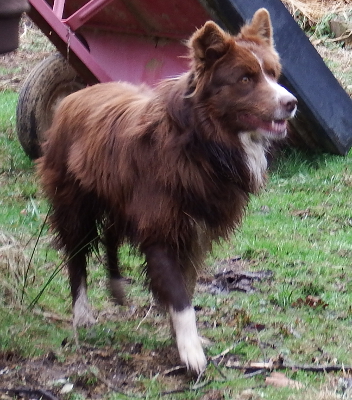 "Looks like [the dog has] already found a good home." --- Errol
"Looks like [the dog has] already found a good home." --- Errol
Mark and I did
consider keeping the stray, even though he killed a chicken, requiring
us to tie him up. He's very responsive, and I'm confident we could turn
him into an asset to the farm just like Lucy is...but it would take a
lot of work. We had to give Lucy about an hour of training
per day for a month or two before she turned into the well-behaved
guardian she is, and neither Mark nor I feel up to throwing that kind of
concerted attention at a dog while we're waiting for our first
goat-kidding experience.
So, instead, we called
two local vets and the animal-control officer and put up a flier in the
post office an an ad on craigslist...but no nibbles yet. In the
meantime, I've been grumpy because a tied dog makes me sad, and his
presence also means that our shy cat only came inside for two hours
Monday night before fleeing back to a dog-free zone. I never realize how
carefully managed our farm is until someone inserts a monkey wrench and
our systems all get twisted askew.
Mark and I have
learned one very important thing from this experience, though: no
matter how well-behaved a dog seems, it should be treated as a
chicken-killer until proven otherwise. The next nice stray who arrives
will be tied up immediately to protect our flock.
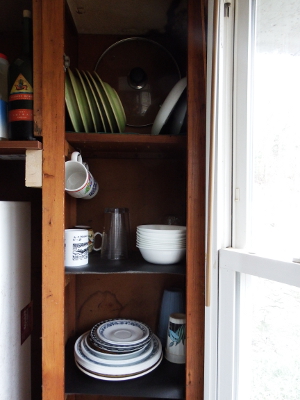
Our trailer came with lots of shoddy cabinets.
I took the door off the last one this week and added extra shelves to turn it into a clutter-free storage location.
Next item on the rainy-weather organization list is to take a stab at the barn.
 Note
from Anna: One of our readers kindly sent along a copy of his parents'
homesteading memoir several months ago, and I promptly passed the book
on to my mother, who enjoys memoirs a lot more than I do. She, in turn,
emailed me a review, which I'm including in slightly edited form below.
Note
from Anna: One of our readers kindly sent along a copy of his parents'
homesteading memoir several months ago, and I promptly passed the book
on to my mother, who enjoys memoirs a lot more than I do. She, in turn,
emailed me a review, which I'm including in slightly edited form below.
In reading Journeying Earthward
by Edith and John Rylander, I was sort of transported to their
Minnesota countryside more than to their way of life. But partly because
the way of life was more known to me, while the place is so new. As I
read amazing facts (about the long winters, for example, and all the
returning birds in spring), I kept, in my soul, looking upward, as if up
along the trunks of the remaining 2% of white pines, and actually
breathing in the wonderful piney smell.
Their life story as both English teachers and writers, is partly comparable to the Nearings, but so unique because of their own
personal experiences in their youths. John helped his grandfather bring
in the hay when he was five or six, driving the horse-drawn haywagon.
Then he worked, at about age 15 or so, in lumberjacking logjams on the
Upper Mississippi. Edith's was the cannery experience for five summers
in Sunnyvale, California, where she learned from her co-workers that
education was the answer because "they can't take away what is in your
mind." She also learned to distrust and resist the regimentation of
mindless, menial work in a factory setting. Working that way, she "sold
her life," and it was this that made her want to try the "Walden
interlude" in Minnesota.
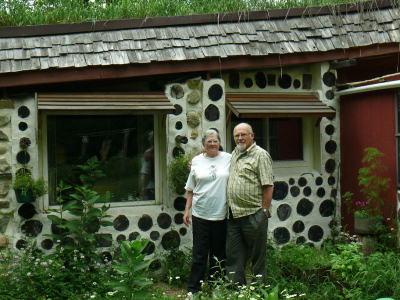 The
authors must be at least 85 and 80 yrs old by now, people who have
earned a role in their choice of location because they have carved out a
unique place in it. Back when they were experiencing the adventures
that gave rise to the book, the Rylanders had a purpose: starting a
small farm from scratch, with chickens, rabbits, and later sheep and
pigs. Pumping their water!
The
authors must be at least 85 and 80 yrs old by now, people who have
earned a role in their choice of location because they have carved out a
unique place in it. Back when they were experiencing the adventures
that gave rise to the book, the Rylanders had a purpose: starting a
small farm from scratch, with chickens, rabbits, and later sheep and
pigs. Pumping their water!
Edith and John chose the
site for their earth-sheltered house on the winter solstice. But they
had lived in that area for many years, and knew the whole pattern of
weather, with the terrible five to six months of hard winter. The fact
that their underground house only needed about 2 1/2 cords of wood the
whole winter, compared to about 30 cords of wood for their first,
uninsulated house, is amazing. But, so too, is the awareness that of all
the white pine forest, the Big Woods of Laura Ingalls Wilder, there is
barely 2% left.
Note from Anna: The title doesn't appear to be available as an ebook, but used paperback copies can be had for $4,
including shipping, at the moment. If you'd like to immerse yourself
into an authentic back-to-the-land adventure, Journeying Earthward is a
great read for a long, cold winter night. Alternatively, you can enjoy a
photo tour of the Rylanders' underground house on this site, from which I stole the photo in this post.